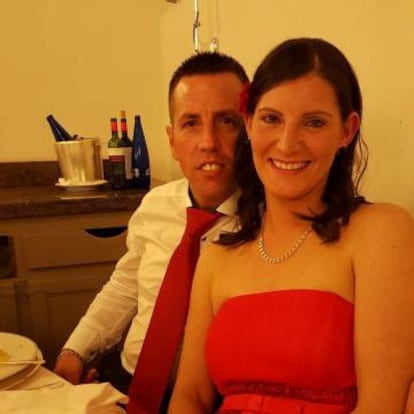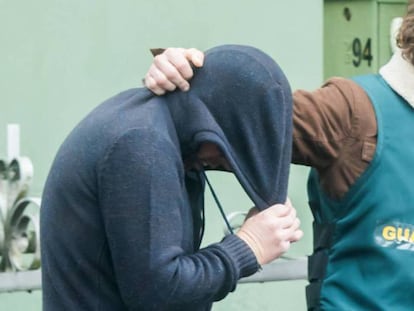The frenzied week that led to the capture of Diana Quer’s suspected killer
A botched abduction helped the police zone in on chief suspect José Enrique Abuín

If he had already been “the main suspect” since November 2016, a year later investigators were “completely certain” that José Enrique Abuín, better known by the nickname of El Chicle, was the man who had abducted Diana Quer, a Madrid teenager who went missing in August 2016 in the small Galician village where she was spending the summer with her family. The case received wide media coverage and police deployed extensive resources to locate the 18-year-old, but her fate remained a mystery.
Investigators were now drafting reports, organizing the information gleaned from analyzing two million cellphone data items, and putting together enough solid evidence to convince the investigating judge, Félix Isaac Alonso, to reopen a case that had been shelved in April.

Nobody working on the case really believed that the crime would be solved over the Christmas holiday, but “events started happening fast” during the last “frenzied week,” explains Javier Jambrina, chief colonel of the Civil Guard in A Coruña. Officers were suddenly forced to “make decisions” and “skip the script” that they had written for themselves setting out to-do lists for the coming weeks and even months.
Two events in particular altered that script, effectively ending El Chicle’s long run of good luck.
The first event was his attempt to abduct another woman on Christmas Day. It was a major slip by a “savvy” criminal who had been watching his own back carefully because he knew he was being followed. The botched abduction in Boiro, halfway between A Pobra (where Diana Quer was vacationing with her family) and Rianxo (where her body turned up) probably followed the same pattern. Except that “all the luck that he had with Diana, he lost completely with this other girl,” notes a Civil Guard official in A Coruña.
Officers were forced to “make decisions” and “skip the script” that they had written for themselves
There is a surveillance camera on a street corner in downtown Boiro that clearly captured the moment when El Chicle turned his car around to follow his new victim. She was staring at her cellphone screen, as Diana Quer had been doing when she sent her last message to a girlfriend. At a news conference, Jambrina revealed that this new victim recorded the ensuing moments by pressing her phone against her chest and touching the voice recording button on the WhatsApp application she was using to text a friend. The app then automatically sent the message, which recorded how El Chicle allegedly attempted to kidnap her by placing a tool against her neck and pretending that it was a knife. The suspect has denied this accusation.
At first, the attacker asked the victim for her phone, but she resisted and offered him all the cash she was carrying instead, around €20. He then appeared to give up, and pretended that it was all a mistake. “Oh, so you’re not Carla?” he is heard saying. But the woman took a look at the license plate on his Alfa Romeo, and at that point he grabbed her and dragged her kicking and screaming towards the trunk of the car.
The victim fought back with all her strength. El Chicle was recovering from surgery to his right shoulder and was having trouble pushing her down into the small compartment and closing the door on her. Two men who were passing nearby heard the screams and ran to the rescue. At that point the woman leaped from the trunk while Abuín jumped into the driver’s seat and sped off. Diana Quer had no such luck on the night she went missing in a deserted stretch of road in A Pobra.
Nobody working on the case really believed that the crime would be solved over the Christmas holiday
The next day, the woman reported the abduction attempt and provided the Civil Guard with details about the car: she remembered the model and part of the license plate. “That belongs to El Chicle,” concluded local officers who knew that he was a suspect in the Quer case.
The second key event took place last Friday. A Galician newspaper revealed that 30 officers from the Central Operations Unit (UCO) had come to Galicia to hunt down the suspect in the Diana Quer disappearance, who could well be the same man who had recently tried to abduct another woman in Boiro.
That same morning, in light of “the very serious information leak, which is being investigated,” the Civil Guard group in charge of the Diana Quer case held an emergency meeting and decided to arrest El Chicle and his sentimental partner, who together with two in-laws had been supporting his alibi.
Events began to unfold quickly after that: the partner finally admitted on Saturday of last week that El Chicle had not been with her on the night of August 22, 2016, stealing fuel at the port of A Pobra as she had claimed all this time. That was the night that Diana Quer went missing.
After losing this alibi, Abuín first told the Civil Guard that he had accidentally hit Diana Quer with his car, left her body in an industrial park in A Pobra, then gone back for it and tossed it into the sea in Taragoña (Rianxo), near the spot where her cellphone turned up.

A few hours after that, the suspect called out to officers from his holding cell in A Coruña and asked to make a new statement in the presence of his lawyer. He maintained his version about a car accident, but said the body was in a different place now. Officers had not believed the story about throwing the body into the sea, but they did believe this latest version of events.
Diana’s body was indeed where El Chicle said, inside a cistern 10 meters deep in the basement of an abandoned warehouse in Asados (Rianxo). The deposit was filled with cold freshwater that maintained a constant temperature and did not contain any living organisms. This helped preserve the body in a state described as “saponification” in forensic medicine.
The cistern was covered with a heavy slab of stone a meter and a half in diameter that firefighters were only able to move by attaching it to a truck. But there is a trap door that the suspect presumably opened to push Diana’s body through. A trained dog clearly indicated that this was the spot, and an underwater camera then confirmed that the body was inside. A cement block had been tied to the waist, and another one to the shoulders. Her handbag was still there, and so was a plastic cable tie. Fernando Serrulla, a forensic anthropologist based in Verín (Ourense), is now trying to determine whether the cable tie was used to strangle Diana or to handcuff her.
English version by Susana Urra.
Tu suscripción se está usando en otro dispositivo
¿Quieres añadir otro usuario a tu suscripción?
Si continúas leyendo en este dispositivo, no se podrá leer en el otro.
FlechaTu suscripción se está usando en otro dispositivo y solo puedes acceder a EL PAÍS desde un dispositivo a la vez.
Si quieres compartir tu cuenta, cambia tu suscripción a la modalidad Premium, así podrás añadir otro usuario. Cada uno accederá con su propia cuenta de email, lo que os permitirá personalizar vuestra experiencia en EL PAÍS.
¿Tienes una suscripción de empresa? Accede aquí para contratar más cuentas.
En el caso de no saber quién está usando tu cuenta, te recomendamos cambiar tu contraseña aquí.
Si decides continuar compartiendo tu cuenta, este mensaje se mostrará en tu dispositivo y en el de la otra persona que está usando tu cuenta de forma indefinida, afectando a tu experiencia de lectura. Puedes consultar aquí los términos y condiciones de la suscripción digital.
More information
Archived In
Últimas noticias
From Andorra to Gibraltar, a black market for Ozempic exploits its success: ‘They’re the most sought-after products in the world’
From Hungary’s Orbán to Chile’s Kast: How Trump helps turbo charge the far right
Magnets in their heads: How some animals guide themselves using the Earth’s magnetic field
The brief rise and retreat of Generation Z in Mexico
Most viewed
- Why we lost the habit of sleeping in two segments and how that changed our sense of time
- Trump’s obsession with putting his name on everything is unprecedented in the United States
- Charles Dubouloz, mountaineering star, retires at 36 with a farewell tour inspired by Walter Bonatti
- The Florida Keys tourist paradise is besieged by immigration agents: ‘We’ve never seen anything like this’
- Living in a motorhome due to soaring housing prices in Madrid: ‘I got used to it quickly, but I don’t idealize it’










































